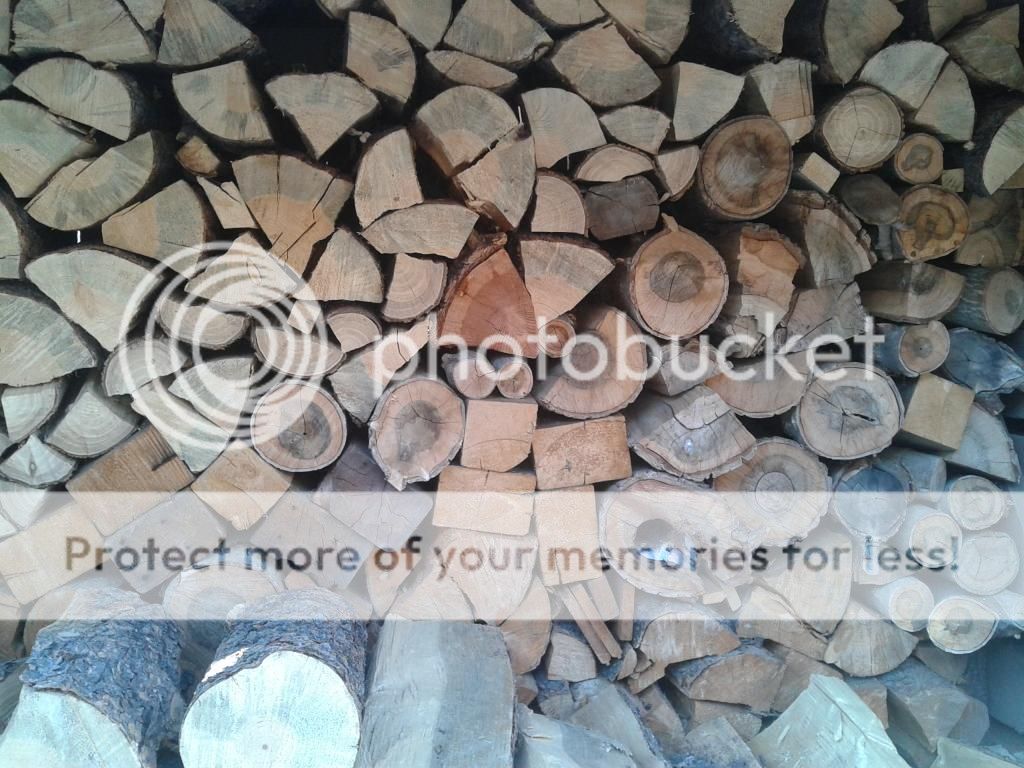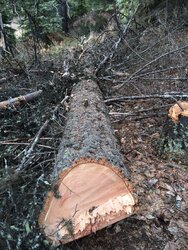wardk
Feeling the Heat
The curved archway door jam you see in the picture on the rounded door was made from one solid block of fir, it was a race against time to get it stained after I cut it because it was so actively splitting and cracking once it was cut out of the block that I could hear and feel it cracking in my hands. Once I got a coat of stain on it it immediately settled down. What you can't see in the pictures are the big cracks that had already developed because I filled them with wood filler and re-stained it. The doors themselves keep shrinking in the summer and swelling in the winter, especially the bigger rounded door. Last summer I had to modify it because it shrunk so much and pulled away from the door catch it didn't catch properly and wouldn't stay closed. Currently the door is so swollen I can't even open it. LOL
The other door has split vertically in several spots, but again I just keep filling the cracks with wood filler and re-staining it, so you don't notice it very much. They may look nice, but they have been way more upkeep then I had ever expected.
Interestingly the wood furniture you see in the pictures is made from white cedar and has the exact same finish as the doors (Sikkens, Cetol 1,2,3), but they have had absolutely no checking or cracking.
Well I was out by the woodshed this morning and something caught my eye that I wouldn't normally had paid much attention to. I found a lonely left over Douglas fir split at the back of the stack, surrounded by some pine and walnut. And yes, it had some obvious checking.
It's the reddish colored split in the middle.

And in case you can't see the checking in above photo, here is a close up.

And a direct link to the picture. http://i1353.photobucket.com/albums/q678/Mucky_Waters/Douglas Fir checking_zpskd08z734.jpg
Glad we can finally put that matter to rest.
The curved archway door jam you see in the picture on the rounded door was made from one solid block of fir, it was a race against time to get it stained after I cut it because it was so actively splitting and cracking once it was cut out of the block that I could hear and feel it cracking in my hands. Once I got a coat of stain on it it immediately settled down. What you can't see in the pictures are the big cracks that had already developed because I filled them with wood filler and re-stained it. The doors themselves keep shrinking in the summer and swelling in the winter, especially the bigger rounded door. Last summer I had to modify it because it shrunk so much and pulled away from the door catch it didn't catch properly and wouldn't stay closed. Currently the door is so swollen I can't even open it. LOL
The other door has split vertically in several spots, but again I just keep filling the cracks with wood filler and re-staining it, so you don't notice it very much. They may look nice, but they have been way more upkeep then I had ever expected.
Interestingly the wood furniture you see in the pictures is made from white cedar and has the exact same finish as the doors (Sikkens, Cetol 1,2,3), but they have had absolutely no checking or cracking.
Well I was out by the woodshed this morning and something caught my eye that I wouldn't normally had paid much attention to. I found a lonely left over Douglas fir split at the back of the stack, surrounded by some pine and walnut. And yes, it had some obvious checking.
It's the reddish colored split in the middle.

And in case you can't see the checking in above photo, here is a close up.

And a direct link to the picture. http://i1353.photobucket.com/albums/q678/Mucky_Waters/Douglas Fir checking_zpskd08z734.jpg
Glad we can finally put that matter to rest.
Cedar is the wood of choice for outdoor furniture but cost about the same as oak here. I still like the straight grain fir doors and the adobe patio .The curved archway door jam you see in the picture on the rounded door was made from one solid block of fir, it was a race against time to get it stained after I cut it because it was so actively splitting and cracking once it was cut out of the block that I could hear and feel it cracking in my hands. Once I got a coat of stain on it it immediately settled down. What you can't see in the pictures are the big cracks that had already developed because I filled them with wood filler and re-stained it. The doors themselves keep shrinking in the summer and swelling in the winter, especially the bigger rounded door. Last summer I had to modify it because it shrunk so much and pulled away from the door catch it didn't catch properly and wouldn't stay closed. Currently the door is so swollen I can't even open it. LOL
The other door has split vertically in several spots, but again I just keep filling the cracks with wood filler and re-staining it, so you don't notice it very much. They may look nice, but they have been way more upkeep then I had ever expected.
Interestingly the wood furniture you see in the pictures is made from white cedar and has the exact same finish as the doors (Sikkens, Cetol 1,2,3), but they have had absolutely no checking or cracking.
Well I was out by the woodshed this morning and something caught my eye that I wouldn't normally had paid much attention to. I found a lonely left over Douglas fir split at the back of the stack, surrounded by some pine and walnut. And yes, it had some obvious checking.
It's the reddish colored split in the middle.

And in case you can't see the checking in above photo, here is a close up.

And a direct link to the picture. http://i1353.photobucket.com/albums/q678/Mucky_Waters/Douglas Fir checking_zpskd08z734.jpg
Glad we can finally put that matter to rest.



